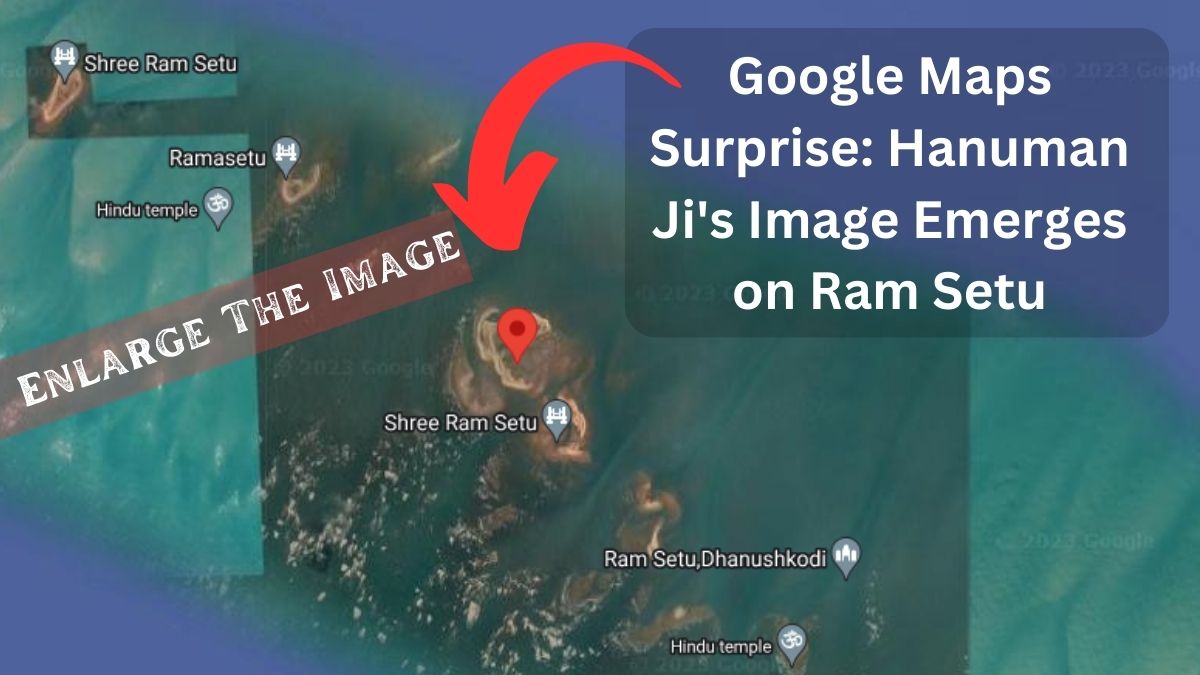
If you’re a devotee of Lord Hanuman, then you’re in for a surprise. The popular navigation app, Google Maps, has captured an image of Lord Hanuman’s face on Ram Setu.
To view the face of Hanuman Ji on Ram Setu – click below Map link
https://goo.gl/maps/TGDW6LhZ4YCPyREj9
Or if you have Google earth just follow the below Video and check Hanumaji Face yourself on you Google Earth App.
For those who are not familiar with Ram Setu, it is a bridge-like structure that is believed to have been built by Lord Rama and his army of monkeys to cross over to Lanka and rescue Sita, his wife, from the demon king Ravana. The bridge is located between the Indian mainland and the island of Sri Lanka, and it has been a subject of fascination and debate for many years.
Recently, a Google Maps user noticed an unusual image on the satellite view of Ram Setu. Upon closer inspection, it was revealed to be an image of Lord Hanuman’s face. The image appears to be a natural formation, caused by the erosion of rocks over time.
Lord Hanuman is a prominent figure in Hindu mythology and is revered for his strength, devotion, and loyalty to Lord Rama. He is often depicted as a monkey, with a long tail and a mace in his hand. Many devotees of Lord Hanuman consider him to be a protector and a source of strength and inspiration.
The discovery of Lord Hanuman’s image on Ram Setu has generated a lot of excitement and interest among devotees and tourists alike. People are flocking to the location to get a glimpse of the image and offer their prayers and devotion to Lord Hanuman.
This discovery is a testament to the power of technology and its ability to bring people closer to their faith and spirituality. It also highlights the significance of Ram Setu and its importance in Hindu mythology.
If you’re planning a visit to Ram Setu, make sure to keep an eye out for Lord Hanuman’s image. It is truly a sight to behold and a reminder of the rich cultural heritage and mythology of India.
Interesting Fact – How it Happened ?
Natural Erosion
The appearance of Lord Hanuman’s face on Ram Setu in Google Maps is believed to be the result of natural erosion. Ram Setu is a chain of limestone shoals that runs between the Indian mainland and Sri Lanka, and it is believed to have been formed over 5,000 years ago. The limestone rocks that make up Ram Setu are made up of calcium carbonate, which is a type of mineral that is susceptible to erosion.
Over time, the waves and currents of the ocean have eroded the limestone rocks, creating small depressions and irregularities in the surface. The natural erosion process has caused the limestone rocks to take on different shapes and forms, including the shape of Lord Hanuman’s face.
It is worth noting that the image of Lord Hanuman’s face on Ram Setu is not visible from the ground, and can only be seen from a satellite view. The image was first discovered by a Google Maps user who was exploring the area on the app.
The discovery of Lord Hanuman’s image on Ram Setu has generated a lot of interest and excitement among devotees of Lord Hanuman, and many people believe it to be a sign of the god’s presence and blessings. The site has become a popular pilgrimage destination for devotees of Lord Hanuman, who come to offer their prayers and seek his blessings.
In conclusion, the appearance of Lord Hanuman’s face on Ram Setu in Google Maps is a fascinating example of how natural processes can sometimes create extraordinary and unexpected phenomena. It is also a reminder of the rich mythology and cultural heritage of India, and a testament to the enduring power of faith and devotion.






